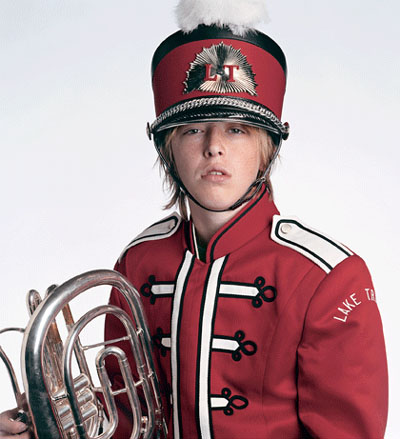 Taylor, 2005 From the series "Troop", Archival digital print, 95 x 88 cm Teresa Hubbard / Alexander Birchler Troop Click for English text Teresa Hubbard (1965) und Alexander Birchler (1962) haben mit Einzelausstellungen im Kunstmuseum St. Gallen, im Museum für Gegenwartskunst Basel, im Museum Haus Lange/Haus Esters, Krefeld, in der Sammlung Goetz, München, in der Pinakothek der Moderne, München, im CGAC, Santiago de Compostela, im Whitney Museum of American Art at Altria, New York und anderen renommierten Institutionen internationale Anerkennung als eine der vielversprechendsten Video- und Fotokünstler ihrer Generation erfahren. Mit der Fotoserie "Troop" bestreitet das amerikanisch-schweizerische Künstlerpaar seine vierte Einzelausstellung in der Galerie Bob van Orsouw. Die Serie, bestehend aus 18 mittelformatigen Farbporträts, steht in einem inhaltlichen Zusammenhang mit dem Video "Johnny", 2004, das von der Galerie auf der diesjährigen Art Unlimited Basel präsentiert wurde. "Johnny" ist das filmische Porträt einer amerikanischen High School Band, in der ein Musiker den aus dem Bürgerkrieg stammenden Song "When Johnny Comes Marching Home" spielt. Der patriotische Song, der heute u.a. noch bei Bestattungen und Sportveranstaltungen gespielt wird, berichtet von einem Ereignis, das noch nicht stattgefunden hat, dessen Eintreten aber suggeriert wird: den militärischen Sieg und die unversehrte Rückkehr des Soldaten Johnny. Der New Yorker Kritiker und Kurator Robert C. Hobbs schreibt: "... "Johnny" is a profoundly moving work of art ... a powerful piece that is political without being partisan and that addresses the plight of being young, very human, and vulnerable in this strange and disconcerting world that we inhabit." Während im Video "Johnny" die Kamera schwebend über regungslose Gesichter, Instrumente und Uniformen gleitet und das Trompetensolo in akustischer Schärfe ertönt, nehmen sich die Farbfotografien aus der Serie "Troop" durch statische Strenge aus. In Anlehnung an die klassische Porträtfotografie posieren die jugendlichen Bandmitglieder vor weissem Hintergrund und blicken frontal in die Kamera. Jedes Porträt ist eine intensive, detaillierte Studie des Verhältnisses von Figur und Raum, von Ausdruck und Innerlichkeit. Die Expressivität der Körpersprache und die stumme Beredtheit der Gesichtszüge verleihen den Porträtierten eine singuläre Präsenz, deren Suggestivität sich der Betrachter nicht entziehen kann. Die den Fotografien eigene Aussagekraft entsteht aus der Spannung zwischen der visuellen Attraktivität der Jugendlichen, die in ihrer Unbedarftheit auf den Betrachter blicken und der historisch aufgeladenen Emblematik ihrer Uniformen, die für die Glorifizierung von Macht, Krieg und Heldentum stehen. Die Gleichförmigkeit der Bildausschnitte von "Troop" resultiert in einem Kompendium von Porträts, deren ästhetische Brillanz, Eindringlichkeit und politische Aktualität an die bekannte Fotografie von Diane Arbus "Boy with a Straw Hat Waiting to March in a Pro-War Parade" (1967) erinnern. Birgid Uccia Ausstellungsdauer 25.11.2005 - 14.1.2006 Öffnungszeiten Di-Fr 12 - 18 Uhr, Sa 11-16 Uhr und nach telefonischer Verabredung Galerie Bob van Orsouw Limmatstrasse 270 8005 Zürich Telefon +41 (0)44 273 11 00 Fax +41 (0)44 273 11 02 Email mail@bobvanorsouw.ch www.bobvanorsouw.ch Teresa Hubbard / Alexander Birchler Troop Teresa Hubbard (1965) and Alexander Birchler (1962) have received international recognition as some of the most promising video and photo artists of their generation - with solo exhibitions at the Kunstmuseum St. Gallen, the Museum für Gegenwartskunst Basel, the Museum Haus Lange/Haus Esters in Krefeld, the Sammlung Goetz in Munich, the Pinakothek der Moderne in Munich, the CGAC in Santiago de Compostela, the Whitney Museum of American Art at Altria, New York, and other renowned institutions. With their photographic series "Troop", the American-Swiss artist couple present their fourth solo exhibition at the Gallery Bob van Orsouw. The series, consisting of 18 medium-sized color portraits, is thematically linked to the video "Johnny" 2004, which was presented by the Gallery at this year's Art Unlimited in Basel. The video, "Johnny" is the filmic scenario of an American high school band in which a musician plays the song "When Johnny Comes Marching Home". This patriotic song, which has its roots in the American Civil War and is still performed today, at burials and sport events for example, tells of an incident that has not yet taken place but is suggestively foreseen: military victory and the safe return of a soldier Johnny. The New York critic and curator Robert C. Hobbs writes of the video: "... "Johnny" is a profoundly moving work of art ... a powerful piece that is political without being partisan and that addresses the plight of being young, very human, and vulnerable in this strange and disconcerting world that we inhabit." In the video, the camera glides past motionless faces, instruments and uniforms while the trumpet solo resounds in acoustic poignancy. In contrast, the color photographs from the "Troop" series display static austerity. In analogy to classic photographic portraiture, the young band members, against a white backdrop, face frontally and look directly into the camera. Each portrait is an intense, detailed study in favor of the relationship of figure and space, outer appearance and introversion. The expressivity of their body language and the mute eloquence of their facial demeanor lend those portrayed a singular presence, whose suggestiveness the viewer cannot escape. The photographs' own power of expression arises from the tension between the visual appeal of the adolescents, who in their naivety look calmly back at the viewers, and the historically charged emblems of their uniforms that stand for the glorification of might, of war and of heroism. The precise repetition of format and cropping in the "Troop" series results in a compendium of portraits whose aesthetic brilliance, immediacy and political actuality recall the well-known photo by Diane Arbus "Boy with a Straw Hat Waiting to March in a Pro-War Parade" (1967). Birgid Uccia Exhibition November 25, 2005 - January 14, 2006 Gallery hours Tues-Fri noon - 6 pm, Sat 11 am - 5 pm |